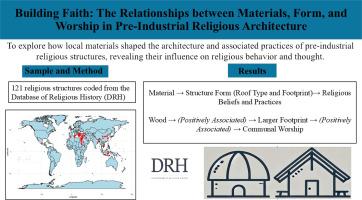建立信仰:前工业宗教建筑中材料、形式和崇拜之间的关系
IF 2.2
Current research in ecological and social psychology
Pub Date : 2025-01-01
DOI:10.1016/j.cresp.2025.100231
引用次数: 0
摘要
传统上,宗教结构被视为信仰和实践的反映,但它们的设计也可能塑造宗教行为和思想。本研究使用来自宗教历史数据库(DRH)的数据和121个遗址的额外编码,调查了当地材料如何与建筑和工业前宗教结构的相关实践相关联。结果显示,像石膏和粘土这样的延展性材料与弯曲的屋顶有关,而木材与更大的结构有关。较大的建筑更有可能支持集体崇拜,而弯曲的屋顶则与个人崇拜负相关。路径分析表明,材料与宗教习俗之间的关系是由这些材料所提供的建筑特征(如大小和屋顶类型)来解释的。虽然在本质上是相关的,但研究结果说明了物质限制在塑造宗教建筑和实践方面的潜在作用,以及宗教生活在其物质和空间背景中的嵌入性。本文章由计算机程序翻译,如有差异,请以英文原文为准。

Building faith: the relationships between materials, form, and worship in pre-industrial religious architecture
Religious structures have traditionally been seen as reflections of beliefs and practices, yet their design may also shape religious behavior and thought. This study investigates how local materials are related to the architecture and associated practices of pre-industrial religious structures, using data from the Database of Religious History (DRH) and additional coding of 121 sites. Results reveal that malleable materials like plaster and clay are linked to curved roofs, while wood is associated with larger structures. Larger buildings were more likely to support communal worship, whereas curved roofs were negatively associated with individual worship. Path analyses suggest that the relationship between materials and religious practices is accounted for by the architectural features, such as size and roof type, that those materials afford. Though correlational in nature, the findings illustrate a potential role of material constraints in shaping religious architecture and practices, as well as the embeddedness of religious life in its material and spatial context.
求助全文
通过发布文献求助,成功后即可免费获取论文全文。
去求助
来源期刊

Current research in ecological and social psychology
Social Psychology
CiteScore
1.70
自引率
0.00%
发文量
0
审稿时长
140 days
 求助内容:
求助内容: 应助结果提醒方式:
应助结果提醒方式:


